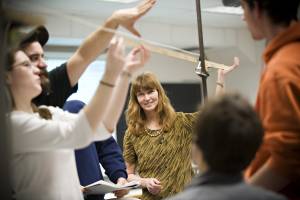Navigation Links
 Physics is an experimental science and experiments produce new puzzles to ponder and they guide theories. Students gain new insight from reconciling words and equations with physical phenomena. Integrating labs into lectures brings home the intimate relationship between the two and forces students to embrace the concept of a model. The integrated lab is a powerful learning tool because the modeling (or “theory”) process and the measurement process are seamless, eliminating the traditional separation of “the lab” and “the lecture”, which, in our opinion, is antagonistic. In the traditional mode, students complain that they “haven't covered this lab in lecture, yet”, or that they “don't know what this theoretical stuff is about”, whereas in an integrated lab, the joy of discovery (either experimental or theoretical) is immediately complemented.
Physics is an experimental science and experiments produce new puzzles to ponder and they guide theories. Students gain new insight from reconciling words and equations with physical phenomena. Integrating labs into lectures brings home the intimate relationship between the two and forces students to embrace the concept of a model. The integrated lab is a powerful learning tool because the modeling (or “theory”) process and the measurement process are seamless, eliminating the traditional separation of “the lab” and “the lecture”, which, in our opinion, is antagonistic. In the traditional mode, students complain that they “haven't covered this lab in lecture, yet”, or that they “don't know what this theoretical stuff is about”, whereas in an integrated lab, the joy of discovery (either experimental or theoretical) is immediately complemented.
It is important to establish a good working environment early on. Students who are used to the separation of the two learning modes may not appreciate the need to process data in a timely fashion to discuss it in class the next day. Or they may stop working once they have “finished” the experiment, and try to leave to go home to write it up. Old habits die hard.
Differences between integrated labs and stand-alone labs. Integrated fit in with the course and go along with the material that is being taught at that time. Stand-alone don't always mesh really well with the course materials. (cf. OSU's large-enrollment intro chemistry course). In stand-alone labs, you can't change the sequence. Also, there are two separate contexts (e.g. TA vs. instructor). In Paradigms, the instructor knows what the students have been doing and slot the lab in appropriately. Integrated labs have to be more meaningful and require more depth to tie into the rest of the course in many ways. Integrated labs have a better lead in and follow-up.
Analysis: in integrated labs, some is happening in real time. In Paradigms, there is a preliminary discussion of the data in class, then students work at home, then there is a follow-up class discussion. You cycle through and refine it. In stand-alone, the analysis may be done in class or at-home, but when it is done the students never think about it again. There is no synthesis of the analysis by the group. You add structure to the stand-alone lab because the students only have one chance at taking data.
Story about CAM's experience with Spin's the first time. Amanda's reaction. How the worksheet is formatted was determined how the students responses.
Emily has a video from PH 111 with tuning forks. Students explored together. For follow-up activity with sticky tape, Emily gave one piece of paper to each student and then they worked separately.